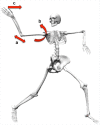The Relationship Between Pitching Mechanics and Injury: A Review of Current Concepts
- PMID: 28107113
- PMCID: PMC5435152
- DOI: 10.1177/1941738116686545
The Relationship Between Pitching Mechanics and Injury: A Review of Current Concepts
Abstract
Context: The overhand pitch is one of the fastest known human motions and places enormous forces and torques on the upper extremity. Shoulder and elbow pain and injury are common in high-level pitchers. A large body of research has been conducted to understand the pitching motion.
Evidence acquisition: A comprehensive review of the literature was performed to gain a full understanding of all currently available biomechanical and clinical evidence surrounding pitching motion analysis. These motion analysis studies use video motion analysis, electromyography, electromagnetic sensors, and markered motion analysis. This review includes studies performed between 1983 and 2016.
Study design: Clinical review.
Level of evidence: Level 5.
Results: The pitching motion is a kinetic chain, in which the force generated by the large muscles of the lower extremity and trunk during the wind-up and stride phases are transferred to the ball through the shoulder and elbow during the cocking and acceleration phases. Numerous kinematic factors have been identified that increase shoulder and elbow torques, which are linked to increased risk for injury.
Conclusion: Altered knee flexion at ball release, early trunk rotation, loss of shoulder rotational range of motion, increased elbow flexion at ball release, high pitch velocity, and increased pitcher fatigue may increase shoulder and elbow torques and risk for injury.
Keywords: baseball/softball; biceps tendon; glenoid labrum; motion analysis/kinesiology; superior labral anterior posterior (SLAP) tear.
Conflict of interest statement
The following authors declared potential conflicts of interest: Markus A. Wimmer, PhD, has grants/grants pending from Biomet, Ceramtec, and Zimmer. Nikhil N. Verma, MD, is a paid consultant for Smith and Nephew; receives royalties from Arthroscopy, Vindico, and Smith and Nephew; and has stock/stock options in Cymedica, Minivasive, and Omeros. Brian J. Cole, MD, MBA, is a paid consultant for Arthrex, Regentis, and Zimmer; receives royalties from Arthrex, DJ Orthopaedics, Elsevier, Saunders, and SLACK; and has stock/stock options in Carticept and Regentis. Anthony A. Romeo, MD, is a paid consultant for, and received payment for lectures from, Arthrex, and also receives royalties from Arthrex and Saunders.
Figures



References
-
- Aguinaldo AL, Buttermore J, Chambers H. Effects of upper trunk rotation on shoulder joint torque among baseball pitchers of various levels. J Appl Biomech. 2007;23:42-51. - PubMed
-
- Aguinaldo AL, Chambers H. Correlation of throwing mechanics with elbow valgus load in adult baseball pitchers. Am J Sports Med. 2009;37:2043-2048. - PubMed
-
- Anz AW, Bushnell BD, Griffin LP, Noonan TJ, Torry MR, Hawkins RJ. Correlation of torque and elbow injury in professional baseball pitchers. Am J Sports Med. 2010;38:1368-1374. - PubMed
-
- Bey MJ, Elders GJ, Huston LJ, Kuhn JE, Blasier RB, Soslowsky LJ. The mechanism of creation of superior labrum, anterior, and posterior lesions in a dynamic biomechanical model of the shoulder: the role of inferior subluxation. J Shoulder Elbow Surg. 1998;7:397-401. - PubMed
-
- Braun S, Kokmeyer D, Millett PJ. Shoulder injuries in the throwing athlete. J Bone Joint Surg Am. 2009;91:966-978. - PubMed
Publication types
MeSH terms
LinkOut - more resources
Full Text Sources
Other Literature Sources
Research Materials

